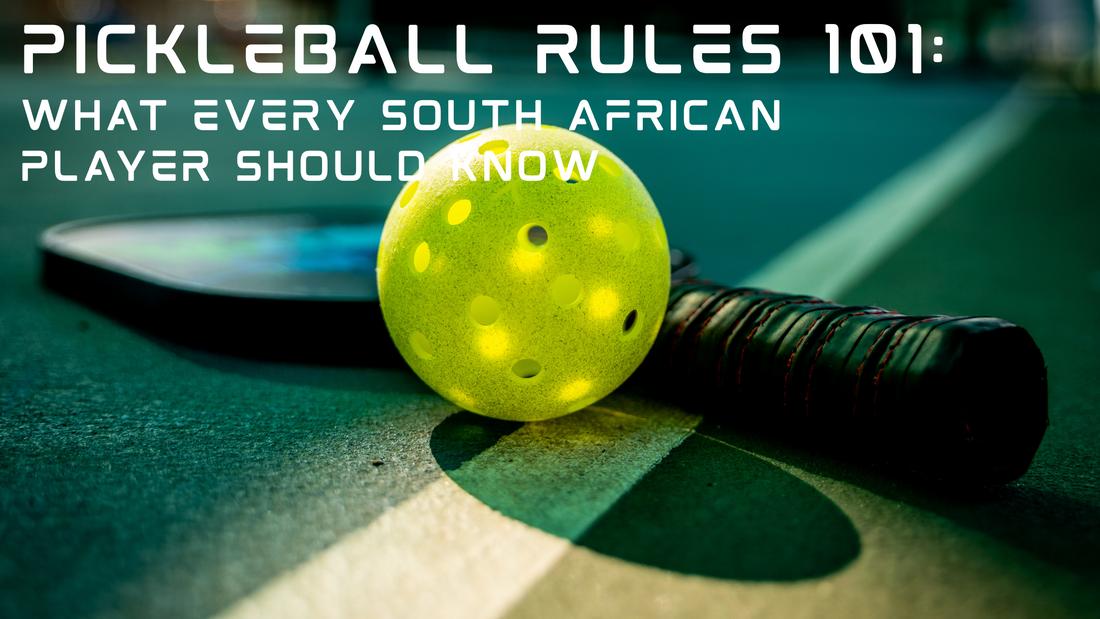
Pickleball Rules 101: What Every South African Player Should Know
Share
aIf you’re stepping onto a pickleball court in South Africa—whether for a friendly rally or your first club match—you’ll want a solid grasp of the rules. Pickleball has a few quirks that make it easy to pick up but strategic to play well. Here’s a clear breakdown of what you need to know.
1. Court Basics & Equipment
- Court size: 20 × 44 ft (same as a doubles badminton court), with a 7 ft non‑volley zone (the “kitchen”) on each side.
- Net height: 36 in at the sides, 34 in at the centre.
- Paddle & ball rules: Paddle length ≤ 17 in, combined length+width ≤ 24 in; paddle must be non‑compressible and smooth. Balls weigh ~23 g and have 26–40 holes.
2. Serving & the Two-Bounce Rule
- Under‑hand serve: Performed below the waist with upward swing, from behind the baseline, into the diagonal opponent’s service box. The ball must clear the kitchen line.
- Two‑Bounce Rule: The receiving side must let the serve bounce once, **then** the serving team must return the ball after one bounce. Only then can volleys begin.
3. The Kitchen (Non‑Volley Zone)
The kitchen is the 7 ft zone near the net where volleying isn’t allowed. You may enter it to hit a bounced ball, but you must plant both feet outside before volleying again—or it's a fault.
4. Scoring System
- Only the serving team can score points. Opponents score by serving if serving team faults.
- Standard games are played to 11 points (often to 15 or 21 in tournaments), and a team must win by 2 points.
- In doubles, each player on a team serves before serve passes. First server only gets one serve at game start; thereafter, both players serve until fault.
- Score is announced as: Serving team score–Receiving team score–Server number (e.g., “5‑4‑2”).
5. Faults: What Can Go Wrong?
- Volleying the ball in the kitchen or touching the line while volleying.
- Failing to let the ball bounce at start, or volleying before two-bounce rule applied.
- Stepping on baseline or into wrong area during serve.
- Hitting ball out of bounds, into the net, or allowing double bounce.
- Faulting on serve (e.g., not clearing kitchen) ends rally.
6. 2025 Rule Updates
According to USA Pickleball and Global Pickleball Federation, rule adjustments in 2025 include:
- Clarifications on momentum: You may not re-enter the kitchen after a volley if your momentum carried you in.
- Time‑out and substitution protocols adjusted for tournaments.
- Minor refinements to serving and line call procedures (see official rulebook)
7. Basic Play Etiquette & Tips
- Call your own lines honestly—when in doubt, say “in”
- Maintain clear communication—“yours” or “mine” helps avoid collisions.
- Warm up with light stretching and rallies to avoid injury.
8. Tournament vs. Recreational Play
Recreational games are more relaxed—call balls in/out, skip time‑outs, and play socially. Clubs typically follow official rules, especially for organized events or tournaments. Familiarise yourself with the newest Global Pickleball Federation/USA rulebook when playing competitively.
Final Thoughts
With this guide, you're ready to hit the court with confidence. Remember the key pillars: under‑hand serve, two‑bounce rule, respect the kitchen, play fair, and only the server scores. Follow etiquette, stay updated on rule changes, and most importantly—enjoy the game!
Ready to play by the book? Visit International Federation of Pickleball – Official Rulebook for full details, then head to a local Pickleball Zone SA clinic or court to practise.
Internal Linking Ideas:
- “How to Start Playing Pickleball in South Africa”
- “Top Pickleball Drills to Improve Your Game”
- “Where to Play Pickleball in South Africa”
External Link: International Federation of Pickleball – Official Rulebook
